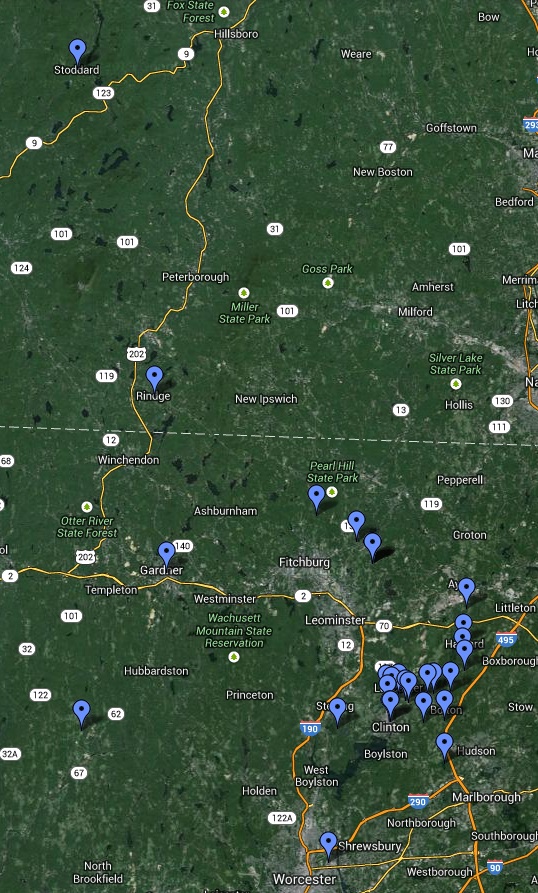Lancaster is the oldest town in Worcester County. The idea for a town actually started with the Indians. The sachem of the Nashaways recommended his valley for an English settlement to Thomas King, a trader in Watertown, probably to give the Indians easier access to trade with the English. In 1643 Thomas King found several associates to join him in buying the land from the Indians, including our ancestor JOHN PRESCOTT. King, along with his partner Henry Symonds of Boston, built the first building in Lancaster that same year, a trucking house located on the southeast side of George hill. By the end of 1644, there were two more houses built, and three settlers were living in Lancaster: Richard Linton, his son-in-law Lawrence Waters, and John Ball (brother of NATHANIEL BALL of Concord; his family remained in Watertown). However all of the original associates dropped out or died (Symonds died in 1643 and King in 1644) except for PRESCOTT, who became the first permanent resident of Lancaster. The town grew slowly at first, and was hampered by a lack of freemen: in 1657, only three out of around 30 proprietors were free. The town asked the General Court to fix the problem, and it appointed 3 commissioners (EDWARD JOHNSON of Woburn, Major Simon Willard of Concord, and Thomas Danforth of Cambridge) to chose selectmen and guide the town.
Of all the towns affected by King Philip's War, Lancaster probably fared the worst. Being on the western edge of the English settlements, with a huge gap between Lancaster and the Connecticut River settlements, the town was easy prey for the Indians. The first attack occurred on Aug 22, 1675, when eight persons were killed. In six months, on Feb 10, 1675/6, came the massacre. There were about 50 families living in Lancaster at this time,with five garrison houses. The Indians attacked three of the garrisons, with the worst outcome at the house of the minister, Mr. Rowlandson, where 42 people fled. After two hours of attack in the early morning, the Indians found a way to set fire to the rear of the house. Only one person escaped; the rest either died or were taken prisoners. In the entire town, 50-55 people were slain. The survivors congregated in two of the remaining garrison houses, and included ancestors JOHN and JONATHAN PRESCOTT and JOHN HOUGHTON. A petition was immediately sent to Boston requesting carts to remove them all to a place of safety. Every white person left, and when they did, the Indians finished the job and burned all of the remaining houses except for the meeting house and one dwelling. Later that spring, most of the captives including Mrs. Rowlandson were ransomed with the help of JOHN HOAR of Concord. But the town of Lancaster was gone, completely empty for a year or two. The return of settlers happened slowly, until 17 or 18 families had returned by 1681. Lancaster was attacked by Indians one more time in its history, during Queen Anne's War in 1704. Four men were killed in that raid.
No records of Lancaster remain from the War until after 1700. It grew sufficiently that other towns started to be carved from it's territory, including Harvard in 1732, Bolton in 1738, Leominster in 1740, Sterling in 1781, Berlin in 1784, Boylston in 1786, and finally Clinton in 1850.
The families below are listed alphabetically, except for the Prescott family, which must be first as the founder of Lancaster.
|-Silas Welch
| |-Nathaniel Meriam
|-Mary Meriam-|
|-Ester Muzzy
The Meriam family lived in Lexington until some time after 1757 when their last child was born. They next appear in Harvard, where MARY MERIAM married SILAS WELCH of Bolton in 1766 (see the Welch family in this chapter). NATHANIEL died in Harvard in 1783. I do not know where or when ESTHER died.
|-John Prescott
Jonathan Prescott-|
|-Mary Platts
We have a number of ancestors who are considered the founders of their respective towns, such as Rev PETER BULKELEY of Concord, PETER HOBART of Hingham, EDMUND RICE of Marlborough, and EDWARD JOHNSON of Woburn. These were all powerful leaders during the formative years of their towns, but all of them shared the founding tasks with others, and none of them carried the full weight of the pioneering effort on their shoulders, such as the Crawford family did in the founding of Steamboat Springs. The Crawfords spent five years in Steamboat as the only permanent pioneering family in the area, and had to conquer all of the survival tasks of obtaining food and building shelter and earning a livelihood entirely on their own. The one Massachusetts ancestor who came closest to matching the pioneering experience of James H. Crawford in Steamboat Springs was JOHN PRESCOTT in Lancaster, Massachusetts.
As with most of our ancestors, we know little more than a few isolated details of his life in England. He was born the youngest son of RALPH and ELLEN PRESCOTT of Shevington, Lancashire, England, just northwest of Manchester. He was baptized in 1604-5 and married Mary Platts at Wigan, Lancashire, on January 21, 1629. He owned land in Shevington, but sold it and moved to Sowerby in Yorkshire. The Prescotts had one son and three daughters born in England before they left in 1638 and landed in Barbados, where JOHN owned land and another daughter was born. They only stayed in Barbados two years, before they moved to Watertown. JOHN acquired six lots of 126 acres of land in Watertown, including their home on a 3 acre parcel of land on the southeast corner of what is now Mt. Auburn St. and Arlington Street, across Arlington St. from the Old Burying Ground. One more daughter was born in Watertown. In 1643, JOHN joined with Thomas King and eight other associates to buy land from the Nashaway Indians, far to the west of Concord.
The Prescott family did not move immediately to Nashaway. With six children under the age of 14, they would have been cautious and wanted to ensure they had shelter and supplies to last the cold New England winters. He sold his Watertown holdings and headed to Nashaway with his family, horses and cattle in June of 1645, the first permanent settlers, and first family in Lancaster. The principle obstacle on their way to their new home was the "Sudbury Swamp". Governor Winthrop in his "History of New England" stated "Prescot another favorer of the Petitioners lost a horse and his loading in Sudbury river, and a week after his wife and children being upon another horse were hardly saved from drowning." JOHN complained to the General Court, which immediately ordered a bridge built, and gave Sudbury £20 to build it.
JOHN's first lot included the grounds where the Lancaster city hall now stands, but he soon chose to make his log cabin on the southeast side of George Hill, where the original trucking house was located (north corner of the current George Hill Rd and Main St in South Lancaster). He set up his blacksmith shop nearby across George Hill Rd, and a store a few rods northwest of the house (for a while called Prescott Corner). The town grew slowly: by 1647 there were two more permanent settlers, and by 1652 there were nine families. The nine families petitioned the General Court to incorporate the town under the name "Prescott". The Deputies passed the incorporation: "Consideringe that there is already at Nashaway about 9 familyes, & that several, both freeman & others intend to goe & settle there,some whereof are named in theire petition, this Court dothhereby give & graunt them libertyes of atownshipp, &, at the request of the inhabitants, doe order it to be called Prescott." But a year later a few highly influential politicians decided it was an outrage to have a town named after an ordinary person, especially since not even the governor had a town named after him. So they changed the name to Lancaster after the English town in the same county where JOHN was born.
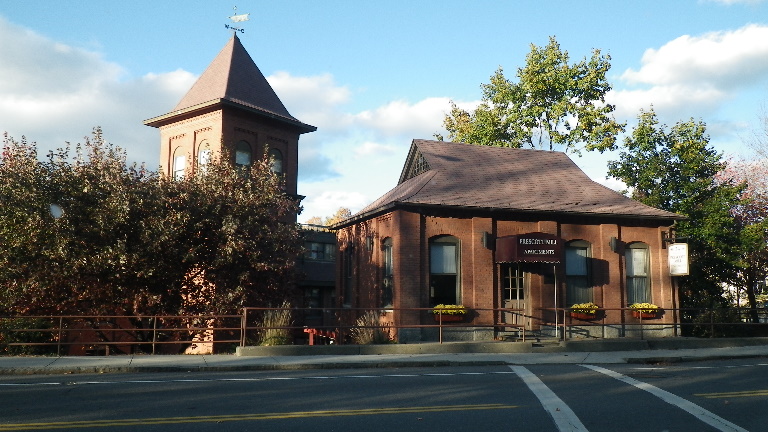 JOHN PRESCOTT may not have had the education that other leaders of that time had, but he was a man who knew how to get things done and was not afraid of hard work. In addition to his stated profession as a blacksmith, he was a farmer, trader, and hunter. He also became a miller because it became obvious that the town needed a mill for grinding corn. Watertown was too far away to have much corn ground there, and the only other option was to grind the corn by hand. JOHN didn't hesitate to tackle the problem, and on March 23, 1654 he opened his grist-mill, the first within Worcester county, and the beginning of a long history of industrialization in the current town of Clinton. He moved to a new home 25 rods east of his mill, on the southeast corner of the current Water St. and High St. in Clinton. Five years later he completed a saw-mill near his grist-mill, and the Precott mills became a central point for the region (the photo shows one of the mill buildings that replaced the original mills and which is now the Prescott Mill Apartments). Finally, in 1667 he contracted to build a corn-mill in Groton, which his son Jonas operated (the mill pond is now in the town of Harvard). JOHN also was a surveyor and builder of roads and bridges. In 1648 he made a new path out to Connecticut via Nashua that avoided alot of hills. In 1657 he was on a committee to build bridges "at Billirriky and Misticke" [Billerica] and in 1658 he surveyed a 650 acre farm that became the chief part of West Boylston.
JOHN PRESCOTT may not have had the education that other leaders of that time had, but he was a man who knew how to get things done and was not afraid of hard work. In addition to his stated profession as a blacksmith, he was a farmer, trader, and hunter. He also became a miller because it became obvious that the town needed a mill for grinding corn. Watertown was too far away to have much corn ground there, and the only other option was to grind the corn by hand. JOHN didn't hesitate to tackle the problem, and on March 23, 1654 he opened his grist-mill, the first within Worcester county, and the beginning of a long history of industrialization in the current town of Clinton. He moved to a new home 25 rods east of his mill, on the southeast corner of the current Water St. and High St. in Clinton. Five years later he completed a saw-mill near his grist-mill, and the Precott mills became a central point for the region (the photo shows one of the mill buildings that replaced the original mills and which is now the Prescott Mill Apartments). Finally, in 1667 he contracted to build a corn-mill in Groton, which his son Jonas operated (the mill pond is now in the town of Harvard). JOHN also was a surveyor and builder of roads and bridges. In 1648 he made a new path out to Connecticut via Nashua that avoided alot of hills. In 1657 he was on a committee to build bridges "at Billirriky and Misticke" [Billerica] and in 1658 he surveyed a 650 acre farm that became the chief part of West Boylston.

Mill Pond in current town of Harvard where John Prescott built his corn-mill
In 1652, JOHN took an oath of fidelity, but he was not a freeman because he had not joined a church. When the town was taken over by a General Court-appointed commission, JOHN was one of five chosen to be selectmen. JOHN remained a selectman at least until 1664 when the commissioners were disbanded and the selectmen were voted by the town. He probably continued long after that, but town records have been lost. JOHN was finally admitted a freeman in 1669, after the laws were changed and freemen no longer needed to belong to a church. He owned 700 acres of land in Lancaster: 100 acres around his original home in South Lancaster; 300 acres around the mills encompasing most of the current densely populated part of Clinton; and 300 acres about Washacum Ponds in the south part of Sterling. He also owned 520 acres around his mill in Groton (now Harvard).
Two more children were born to the Prescotts in Lancaster, including JONATHAN whose birth about 1646 was one of the first two births in the town. JONATHAN grew up to be a blacksmith, and lived in the original Prescott home with the blacksmith shop close by. He married Dorothy in 1670, and they had twins the following year that died immediately. The next year their son Samuel was born, but Dorothy died shortly after in 1674, and is buried in the Old Settlers Cemetery. JONATHAN was a town constable in 1673. He remarried ELIZABETH HOAR of Concord Dec 23, 1675. There is no record of whether they started living in Lancaster or Concord. Two months later JONATHAN was at his father's garrison home on the day of the massacre. One person died in the house, but the major Indian effort was at the Rowlandson garrison house, and the Prescotts were spared. The petition asking for rescue carts was signed by both JOHN and JONATHAN. From that point on, JONATHAN was definitely a resident of Concord. His father-in-law, JOHN HOAR, played a major role in negotiating for the release of Mrs. Rowlandson. JONATHAN never returned to Lancaster, but his father JOHN PRESCOTT did return by 1681, and died in Lancaster in December of 1681. He is buried in the Old Settlers Cemetery along with several of his children and grandchildren. He had 50 grandchildren in all. His will, written in 1673, gave his home and lands by the mills to son John (three more generations of Prescotts lived there), and his Prescott corner land to son JONATHAN, whose son Samuel ended up living there. His third son Jonas got the corn mill land in Groton, and a grandson got the Washacum Ponds land.
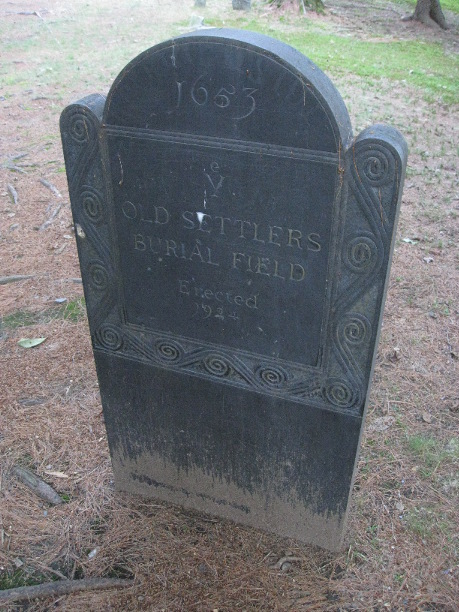
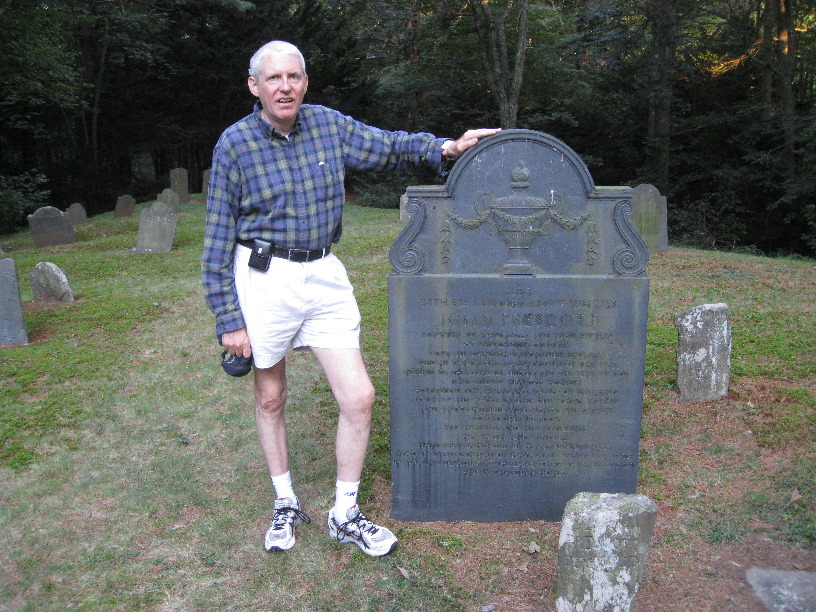
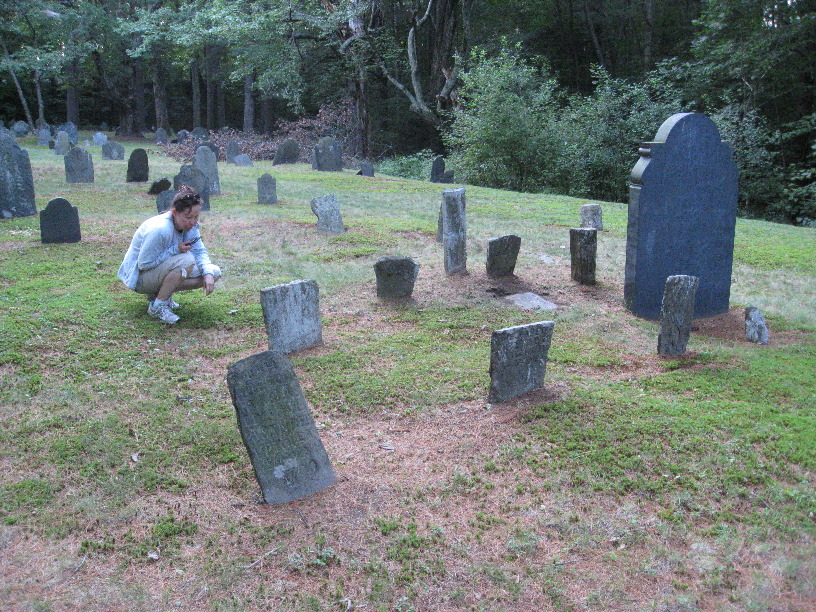
HERE
WITH HIS CHILDREN ABOUT HIM LIES
JOHN PRESCOTT
FOUNDER OF LANCASTER AND FIRST SETTLER
OF WORCESTER COUNTY
BORN AT STANDISH, LANCASHIRE, ENGLAND
DIED AT LANCASTER, MASSACHUSETTS, DEC. 1681
INSPIRED BY THE LOVE OF LIBERTY AND THE FEAR OF GOD
THIS STOUT-HEARTED PIONEER
FORSAKING THE PLEASANT VALES OF ENGLAND
TOOK UP HIS ABODE IN THE UNBROKEN FOREST
AND ENCOUNTERED WILD BEAST AND SAVAGE
TO SECURE FREEDOM
FOR HIMSELF AND HIS POSTERITY
HIS FAITH AND VIRTUES
HAVE BEEN INHERITED BY MANY DESCENDANTS
WHO IN EVERY GENERATION HAVE WELL SERVED THE STATE
IN WAR, IN LITERATURE, AT THE BAR, IN THE PULPIT, IN PUBLIC LIFE
AND IN CHRISTIAN HOMES
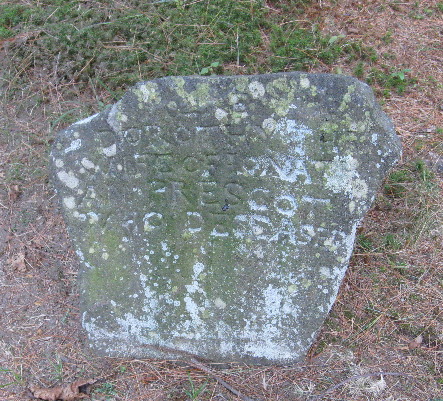
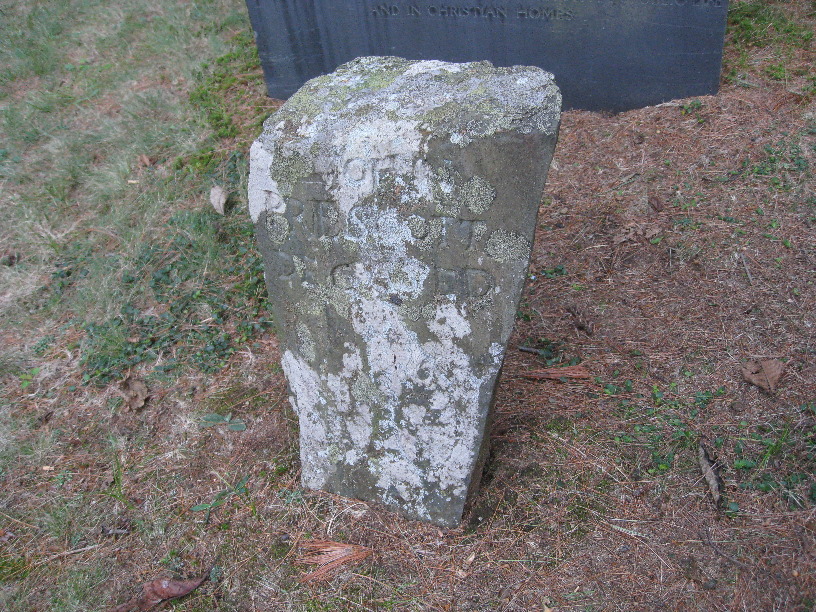
HERE LIES JOHN DOROTHY, THE PRESCOTT WIFE OF JONATH DECASED AN PRESCOT WHO DECEASED [footstone]
|-Stephen Gates
Stephen Gates-|
|-Ann Hill
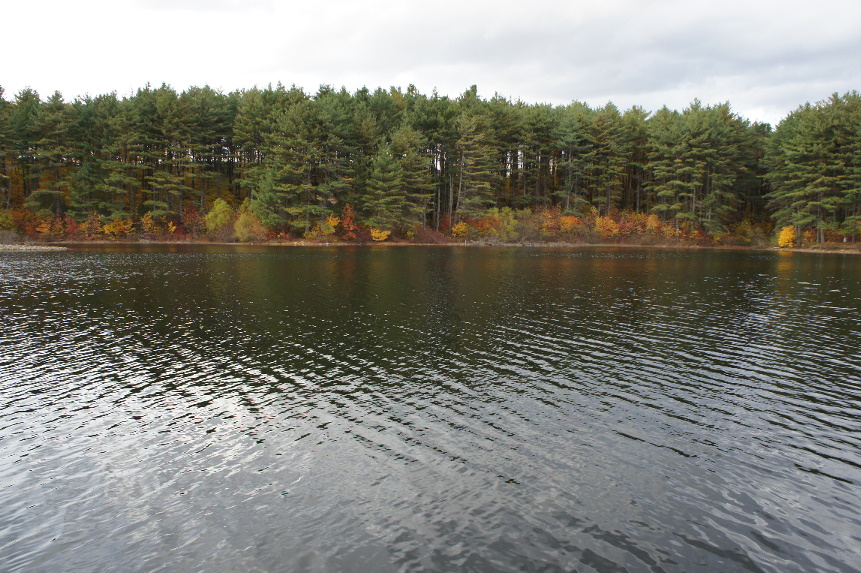 The Gates family had a very nomadic life in Massachusetts. They first settled in Hingham, moved to Cambridge in 1653, Lancaster in 1654, and back to Cambridge where the father died in 1662. The son soon married, lived some in both Boston and Charlestown, and finally moved to Stow. (See the chapters on Hingham, Cambridge, and Sudbury.) On April 3, 1654, STEPHEN GATES signed the covenant agreeing to live in Lancaster and follow the terms of its incorporation. His home of 20 acres was on the road leading northwest (Main St), north of the North branch of the river. He also owned 314 acres of land in the southeast part of the town in what is now Berlin. His land there included a large pond that is still called Gates' Pond. He was the third largest landowner in Lancaster after John White and JOHN PRESCOTT. He bacame a freeman on May 14, 1656 and chosen constable in 1657. However there was a controversy between the Gates family and his neighbors on his south, the Whitcomb families, that deprived STEPHEN of his constable's staff, and he moved back to Cambridge after only three years in Lancaster. When he died, his oldest son, STEPHEN Jr., received his house in Lancaster, but the son never lived there.
The Gates family had a very nomadic life in Massachusetts. They first settled in Hingham, moved to Cambridge in 1653, Lancaster in 1654, and back to Cambridge where the father died in 1662. The son soon married, lived some in both Boston and Charlestown, and finally moved to Stow. (See the chapters on Hingham, Cambridge, and Sudbury.) On April 3, 1654, STEPHEN GATES signed the covenant agreeing to live in Lancaster and follow the terms of its incorporation. His home of 20 acres was on the road leading northwest (Main St), north of the North branch of the river. He also owned 314 acres of land in the southeast part of the town in what is now Berlin. His land there included a large pond that is still called Gates' Pond. He was the third largest landowner in Lancaster after John White and JOHN PRESCOTT. He bacame a freeman on May 14, 1656 and chosen constable in 1657. However there was a controversy between the Gates family and his neighbors on his south, the Whitcomb families, that deprived STEPHEN of his constable's staff, and he moved back to Cambridge after only three years in Lancaster. When he died, his oldest son, STEPHEN Jr., received his house in Lancaster, but the son never lived there.
|-Benjamin Hastings
|-John Hastings -|
Lovice Hastings-| |-Abigail Sawtell
|-Submit Russell
The Hastings family is a little bit of a mystery. A hand-written entry in the Bolton Vital Records clearly records THOMAS WELCH's marriage to LOVICE HASTINGS on Oct 20, 1791, and states that they are both "of this town". But there is no record of LOVICE's birth, either in Bolton or elsewhere, and none of the old genealogical books give any clue as to her parents. However when looking at the births and marriages of other Hastings in Bolton, there is really only one Hastings family (in multiple generations) in Bolton at this time. BENJAMIN HASTINGS married ABIGAIL SAWTELL in Waltham on May 12, 1743. They must have moved to Bolton shortly afterwards, since the birth of their son JOHN on Oct. 5, 1744 is recorded in the Bolton Vital Records, along with six other children. [Actually, we don't know where BENJAMIN was born, nor who his parents are. The Waltham marriage entry does not list him from another town, so presumably he was then living in Waltham, or perhaps Watertown which Waltham was carved out of in 1738. Thomas Hastings immigrated to Watertown in 1634, and had 6 sons, who likewise had many sons. So there were many Hastings families in Watertown in the early 1700s, and it seems that BENJAMIN's parents were obscured in a sea of Hastings.] JOHN's marriage to SUBMIT RUSSELL on Dec 31, 1767, is also recorded, as well as another son, Benjamin, who married in 1782. So the only possible parents of LOVICE are JOHN and SUBMIT. Unfortunately, none of the births of their children were recorded, just the baptisms of four of them, three of which were baptized on the same day in 1786. Purhaps LOVICE was too old then (12) to be baptised. The tombstone of SUBMIT (see below) said she died leaving nine children, so there were at least five un-recorded children.

Submit Hastings' tombstone is center left in this photo.
John and Benjamin Hastings have military stones at the far right
(see near the end of this chapter under Welch)
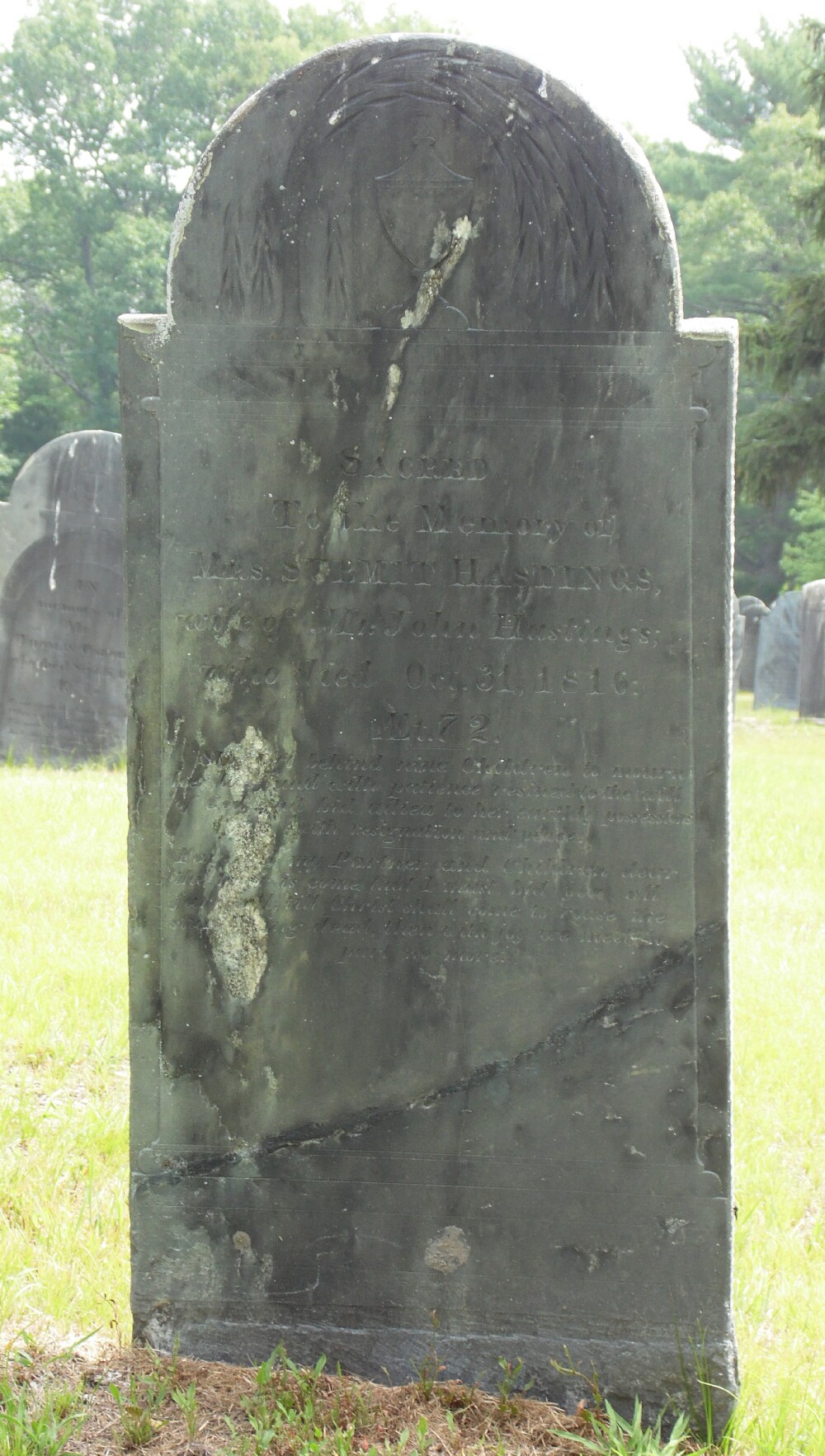
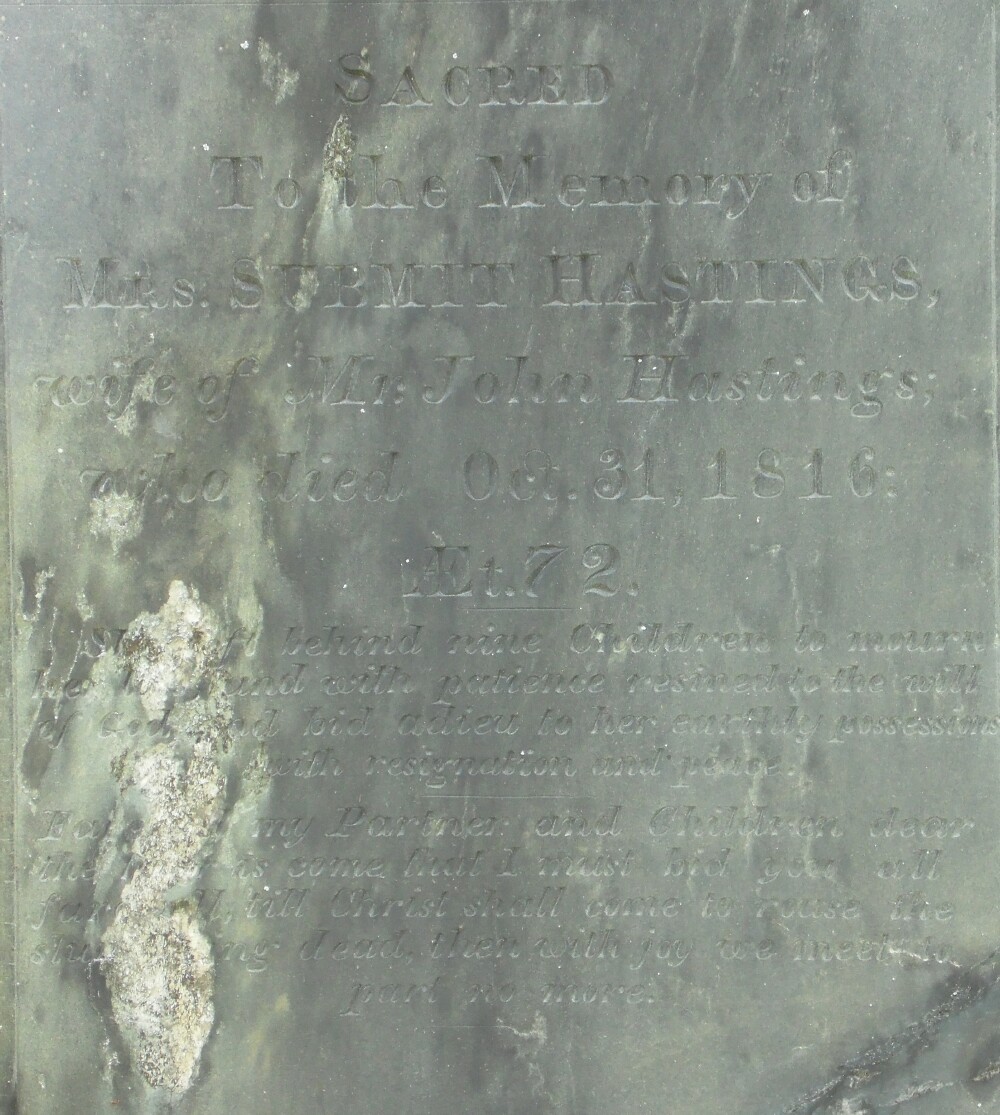
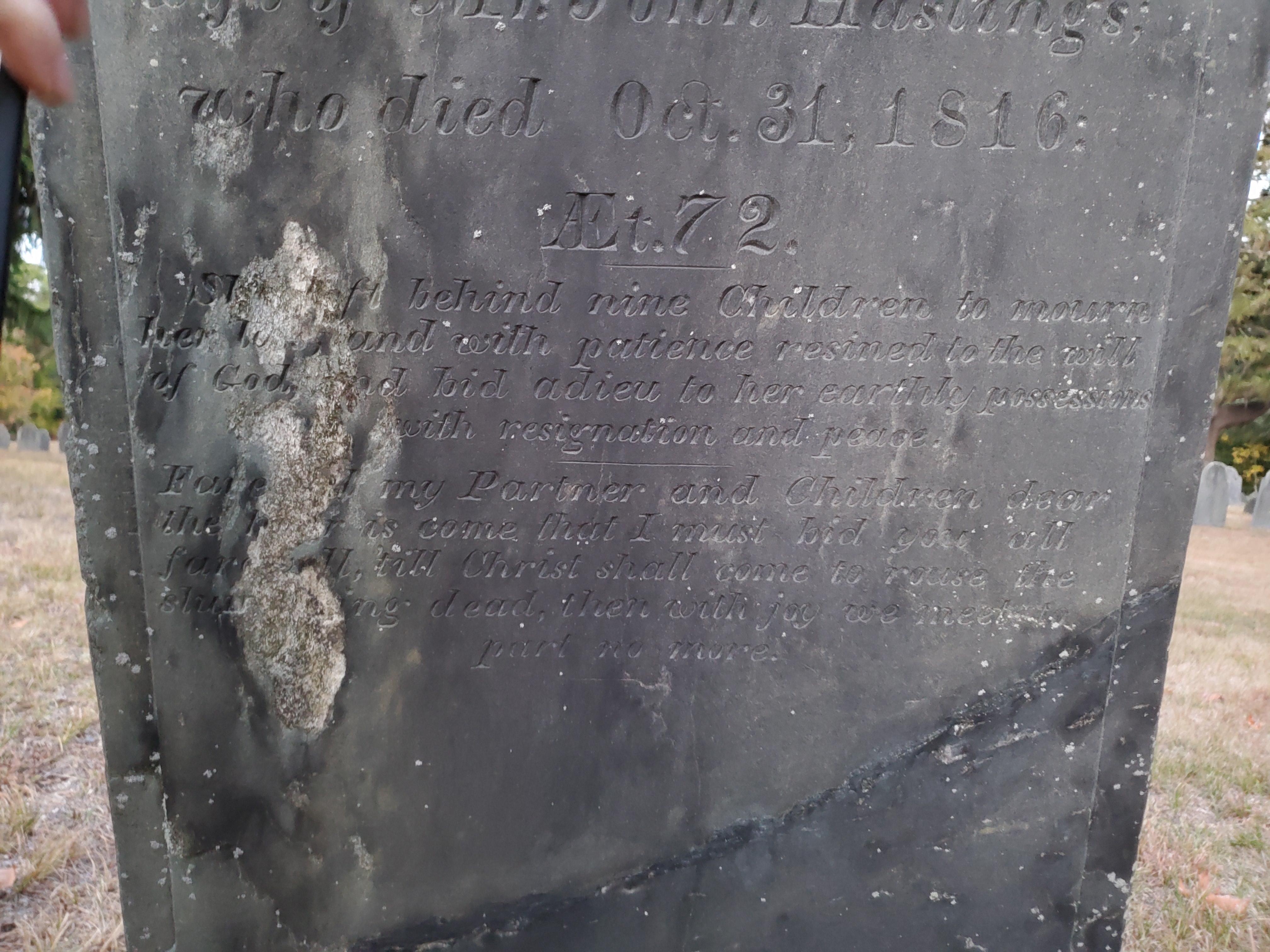
Sacred To the Memory of Mrs. Submit Hastings, wife of Mr. John Hastings, who died Oct. 31, 1816: AEt. 72. She left behind nine Children to mourn her loss and with patience resined to the will of God and bid adieu to her earthly possessions with resignation and peace. Farewell my Partner and Children dear the hour is come that I must bid you all farewell, till Christ shall come to raise the slumbering dead, there with joy we meet to part no more.
Little is known about the Hastings in Bolton other than their military records, which were extensive. BENJAMIN started his service during the French and Indian War. In September of 1755 he was listed as an ensign under Capt. Joseph Whitcomb at the battle of Lake George, New York. In a bloody day of fighting, 8 out of the 50 men in Whitcomb's company died. The Massachusetts soldiers stayed until November, when they returned home for the winter. He had his last child born in 1757, then in 1758 he was back at Lake George listed as a lieutenant in a company under Capt. Asa Whitcomb, and in 1759 he was listed as a captain in Colonel Willard's regiment. According to a diary kept by Lemuel Wood of Boxford, he was dismissed in September with disgrace for mutinous behavior. 16 years later BENJAMIN once again was listed as Captain of a company of minutemen that marched to Cambridge on April 19, 1775, in response to the Lexington Alarm. The men included his son JOHN and SILAS WELCH. Later in June, he was at the battle of Bunker Hill and "led one company of thirty-four, and took post at the rail fence". He continued to lead a company including JOHN and SILAS during the Siege of Boston, where SILAS died. BENJAMIN, JOHN, and SILAS all have military tombstones in the Old South Cemetery. No more is known about BENJAMIN or ABIGAIL until their deaths in 1783 and 1808. [According to some web rumors, ABIGAIL's parents, RICHARD and ABIGAIL SAWTELL may have died in Bolton in 1780 and 1783, but I have found no evidence for them in Bolton.]
|-John Houghton
|-Jonas Houghton-|
|-Jonas Houghton-| |-Beatrix
Betty Houghton-| |-Mary Burbeen
|-Mary Brigham
Two cousins, Ralph and JOHN HOUGHTON, ended up in Lancaster around the time of its incorporation. There is much confusion as to when they first came. A John Houghton age "4" came on the ship "Abigail" in 1635, but there is no record of any John Houghton in any town in the colony before Dedham in 1651 and Lancaster in 1652. Everyone thinks the age was a typo, and it should have been 24, 34, or 40. We can be sure, however, that JOHN and his wife BEATRIX were both born in England, and that most of their seven children, including JONAS, were born in Lancaster. JOHN signed the Lancaster covenant in 1653, and lived on the north side of Deans Brook [now named Goodridge Brook] on the west side of the mill path [probably Main St]. His cousin Ralph was for many years the town clerk, and is mentioned many times in the records of Lancaster. During King Philip's War, the Houghtons lived in Charlestown or Woburn. When they returned, JOHN and his sons built new homes on the east side of the river, to the south of Bridecake Plain (now called Old Common Rd) opposite what are now the grounds of the State Industrial School. JOHN died in 1684, and his gravestone is the oldest stone in the Old Settlers Cemetery.
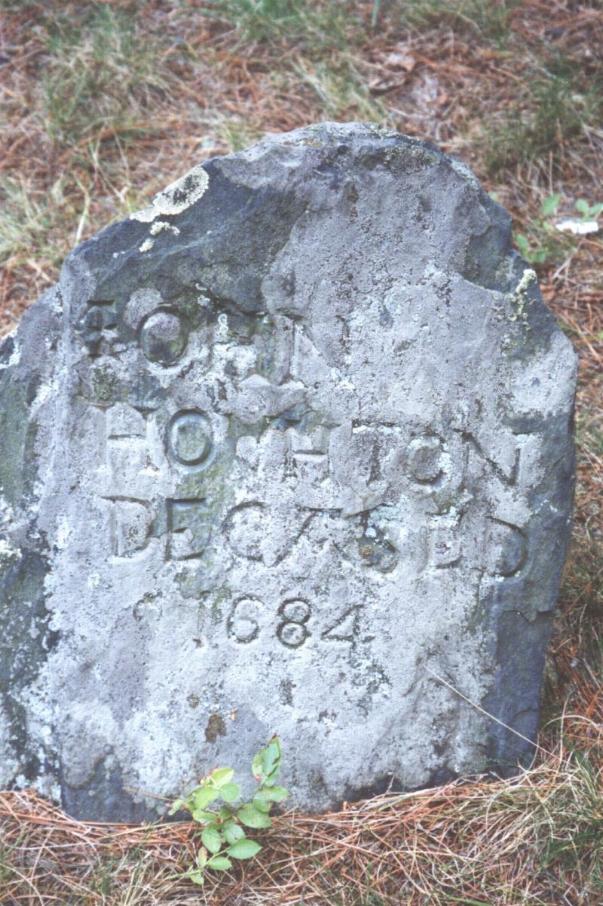
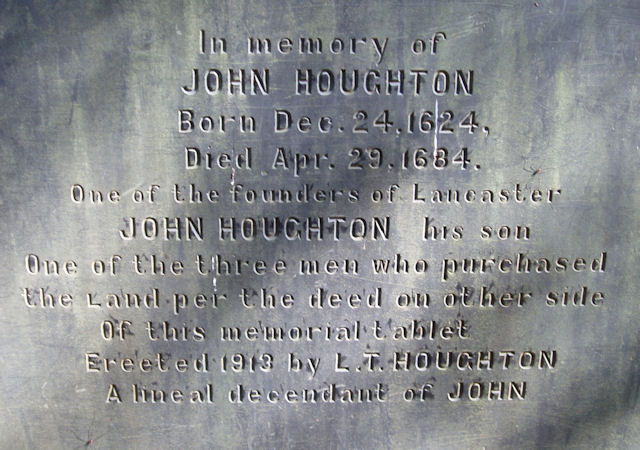
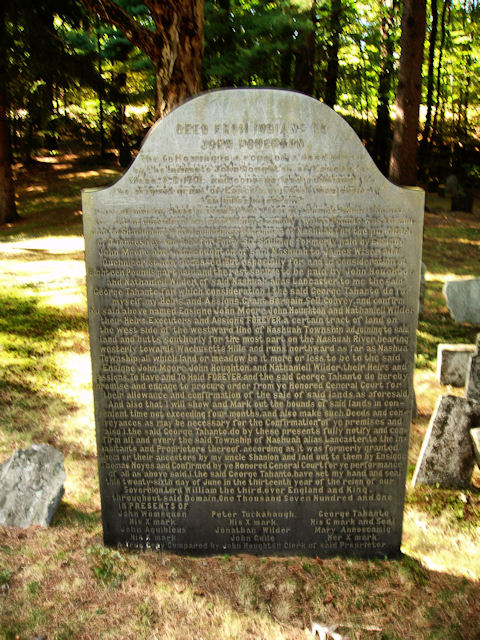
In memory of
JOHN HOUGHTON
Born Dec. 24,1624,
Died Apr. 29,1684
One of the founders of Lancaster
JOHN HOUGHTON his son
One of the three men who purchased
the land per the deed on other side
Of this memorial tablet
Erected 1913 by L. T. HOUGHTON
A lineal decendant of JOHN
JONAS HOUGHTON was born about 1663, and so would have just turned a teenager when the Houghtons fled Lancaster due to the massacre. One source says the Houghtons stayed in Charlestown, and another says Woburn. I favor Woburn, because JONAS probably met his future wife at this time, MARY BURBEAN, who grew up in Woburn. They married in 1681, and settled on his father's land on Vaughn's Hills. Since the Lancaster records during this time were lost, we know nothing about JONAS until the Indian attack on Lancaster in 1704. The list of damages in the town due to the attack includes the item: "JONAS HOUGHTON, one ox". JONAS and his brother John signed a petition requesting that Lancaster be exempt from taxes due to the Indian attack. JONAS is mentioned a few times after that in the records for property descriptions or for fixing property boundary lines. In 1708 he signed the Lancaster Church Covenant; in 1720 he was granted 6 or 7 acres on the top of the southern-most Vans Hill as payment for nine days work in building a bridge; and in 1722 a receipt calls him Constable. He died in 1723, and is buried in the Old Common Burying Ground.
JONAS HOUGHTON Jr. was the oldest son, born in 1682. We know nothing about him until his marriage with MARY BRIGHAM of Marlborough in 1710. They had nine children born in Lancaster including BETTY in 1715/6. On March 2, 1718/9 JONAS was chosen to be a Selectman, and later he also served as Moderator and as Treasurer. He was at one point called "the Lancaster surveyor", and is listed for several surveying tasks, including to reconstruct a road along the north side of Wachusett. The town of Bolton was carved out of Lancaster and incorporated in 1738, and Capt. JONAS HOUGHTON was chosen as one of the five selectmen, along with two of his Houghton relatives. Since the new town clerk was also a Houghton, it is fair to say that the Houghton family controlled the town of Bolton when it incorporated. In 1760 his son, also named Capt. Jonas Houghton, built a house that is still standing at 96 Green Rd, on the land of his father. This house is on the edge of the southern-most Vaughn's Hills, and is on land originally owned by JOHN, then JONAS Sr., and CAPT. JONAS Jr. Capt. JONAS died on Aug 15, 1739, just one year after Bolton was incorporated. He is buried near his father in the Old Common Burying Ground. The inventory of his estate was just over £2000 and included over 100 acres. MARY received 1/3 of the land, while each of the living 6 children received equal shares. BETTY's share was 35 acres of nonimproved land valued at £46.4. When MARY died in 1749, her land was also divided, and BETTY received 11 acres. BETTY married PAUL WELCH in 1740, and our Houghton ancestors end.
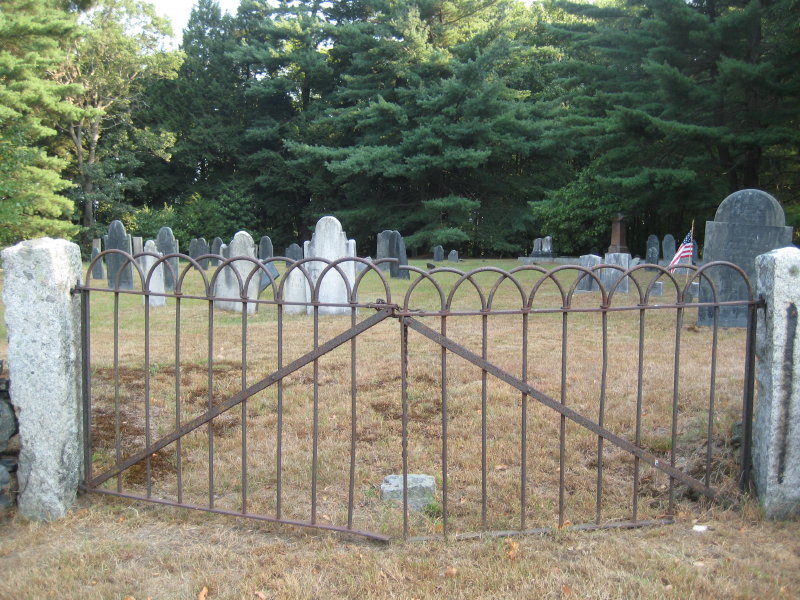
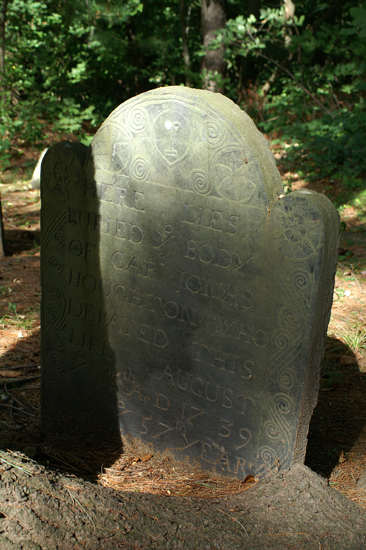
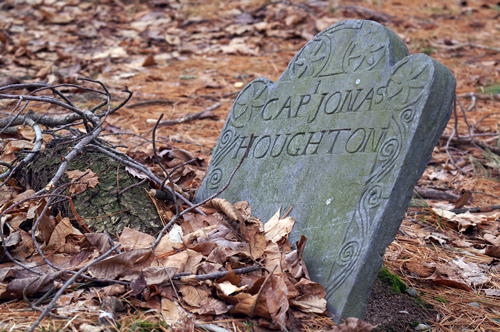
Here Lies Buried ye Body of Capt. Jonas Houghton Who Departed this Life August ye 15th A.D. 1739 In ye 57th Year of His Age.
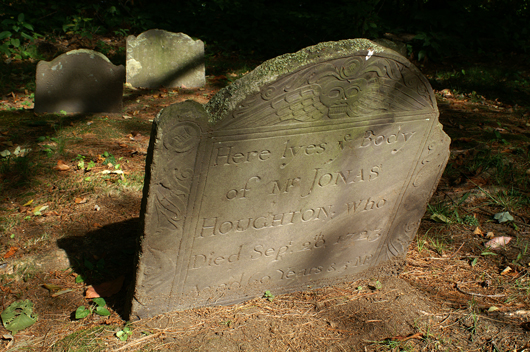
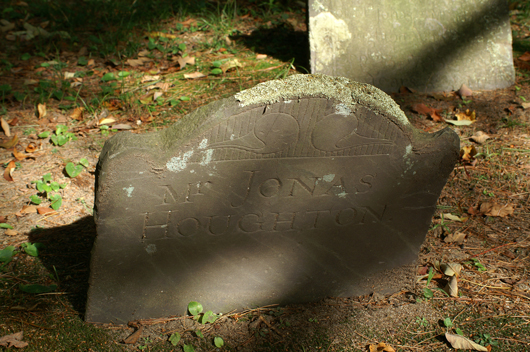
Here Lyes ye Body of Mr. Jonas Houghton Who died Sept 20 1723, Aged 60 Years & 5 mos.
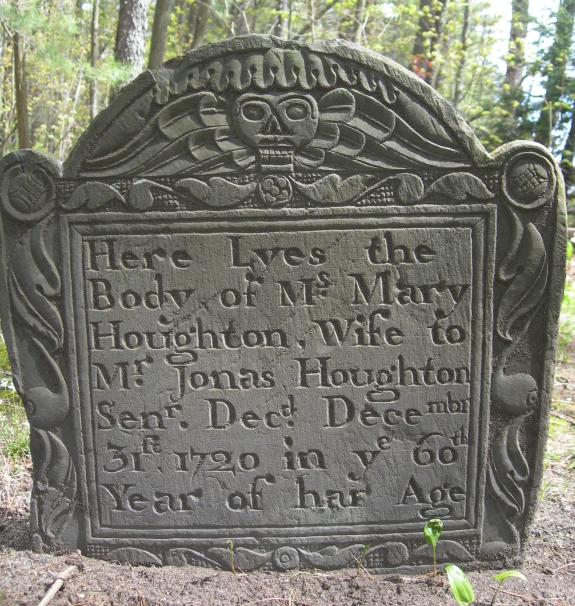
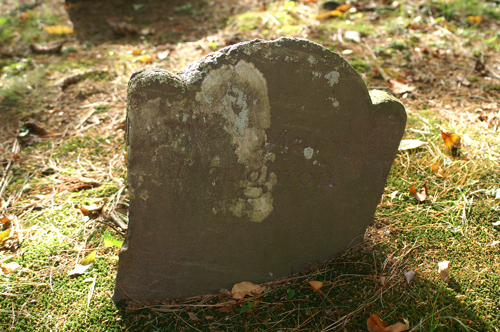
Here Lyes the Body of Mrs. Mary Houghton, Wife to Mr. Jonas Houghton, Sen'r. Deceased December 31st 1720 in ye 60th Year of her Age.
|-Dole Johnson
Hannah Johnson-|
|-Hannah
DOLE JOHNSON was born in Woburn, but after his mother died, DOLE and his father WILLIAM JOHNSON moved to Mansfield, Connecticut. Sometime before 1739 DOLE married HANNAH and moved to Harvard. The births of their three children, including HANNAH in 1739 were recorded in the Harvard records, as was DOLE's death in 1745 at the age of 35. It is not all that surprising that he ended up in Harvard, because his ancestor EDWARD JOHNSON of Woburn had acted as a commissioner of Lancaster and had been granted a large tract of land in the southeastern part of Lancaster. Other descendents of EDWARD moved eventually to this land, so DOLE would have had cousins in the town. He lived on the east side of the Penicook (Nashua) River, bounded on the west by the river and on the south by land of Richard Hall. The
inventory
of DOLE's estate was £208.14.0 with his widow Hannah Johnson being the executrix. After paying off creditors, £74.8.4 1/2 was left for the children. HANNAH married John Davis in 1752 and had four more children. Her daughter HANNAH married BENJAMIN PRIEST in 1761.
|-Philip Knight
Elizabeth Knight-|
|
Jonathan Knight -|
|-Margery
The KNIGHT family first came to Charlestown in 1637, where they lived until 1654 (see the Charlestown chapter). At that time PHILIP KNIGHT bought 20 acres of land in Landcaster from Steven Day, where the KNIGHTs built a house and lived for about five years. The land was 20 rods north-to-south and 160 rods east-to-west, and adjacent to JOHN PRESCOTT's land. Besides the quirk of KNIGHT buying land from Day, his name resulted in some confusion over the name of the town common land. This common land was referred to as the "night pasture", as was the case in other towns, because the commons was the place cows were pastured during the night. However since it was near our ancestor's land, somebody erroneously called it the "Knight pasture", and that is how it was spelled for many years.
|-John Priest
|-Joseph P.-|
|-Joseph P.-| |-Rachel Garfield-|
|-Benjamin P.-| |-Mary Miller |-Mary Benfield
|-John P.-| |-Elizabeth Atkinson
Rebecca P.-| |-Hannah Johnson
|-Rebecca Gibson
JOHN PRIEST was born around 1650, but we are not sure where or who his parents were. One speculation is that his father was John Priest who lived in Charlestown, married Sarah, and sold land on the Reading border in 1680. Another possibility is that his father was James Priest of Dorchester and Weymouth, who emigrated in 1637, married Elizabth, had at least seven children (but none named John!), and recorded his will in 1676. The first definite thing we know about JOHN is that he was impressed into military service from Woburn during King Philip's War, and probably participated in the Great Swamp Fight in December 1675. He married RACHEL GARFIELD of Watertown in 1678, had three children born in Woburn. In 1687 the proprietors of Lancaster offered him 30 acres of land if he would move to Lancaster. They also offered 30 acres to a friend, John Warner, and the two of them moved to a 60 acre parcel on the easterly side of Bare Hill, which is now in Harvard. Four more children were born in Lancaster, including JOSEPH in 1690. JOHN's house was one of the garrison houses used during the Indian attack in 1704 during Queen Anne's War. Ten neighbor men and their families were assigned to his house, including his son John Jr., John Warner, Caleb Sawyer, and James Atherton Sr. and Jr. When JOHN died at the end of 1704, RACHEL continued to live in the house for another 33 years. Her mother MARY (BENFIELD) GARFIELD also lived with her and died in Lancaster in 1709. RACHEL is buried in the Harvard Center Cemetery besides her grandson John Priest and his family.
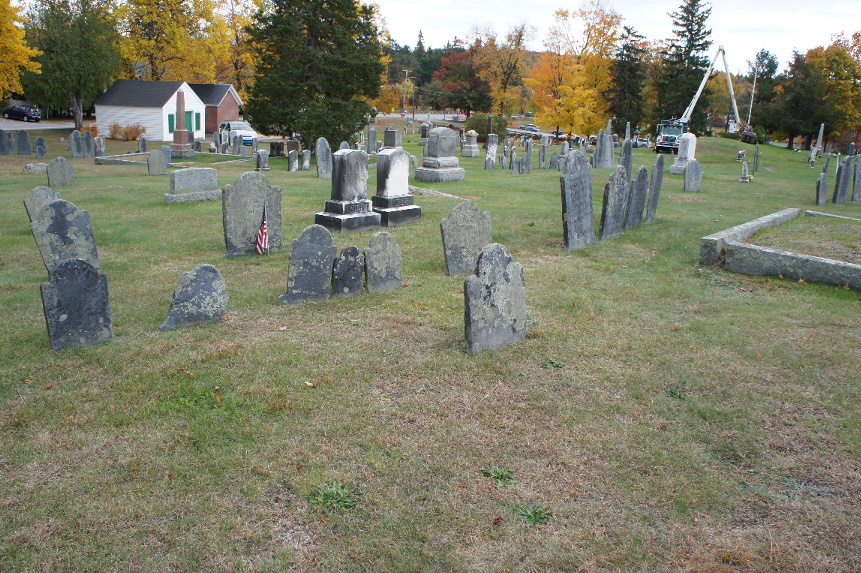
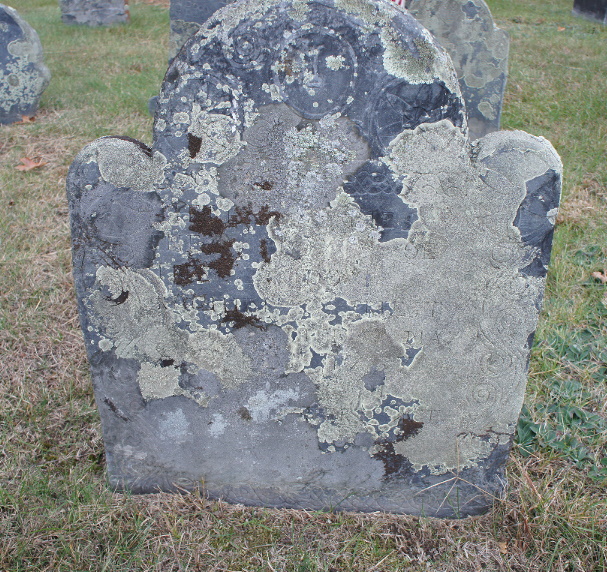
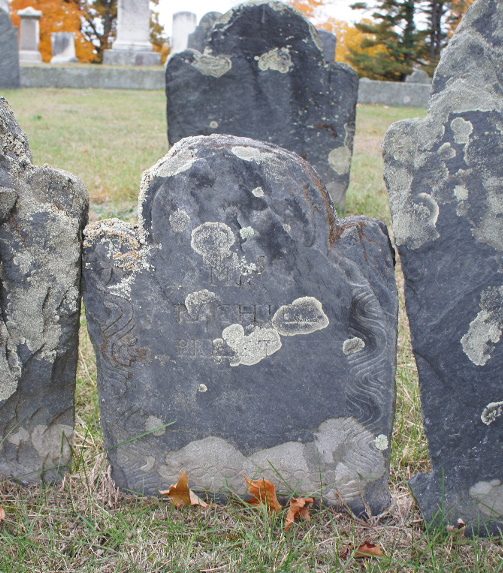
Harvard Center | HERE LIES | MRS
Cemetery | THE BODY OF | RACHIEL
THE WIDOW | PRIEST
RACHIEL PRIEST | (footstone)
WHO DIED MAY
17 1737
IN THE 81
YEAR OF HER AGE
BENJAMIN PRIEST was born in 1738, after the town of Harvard was created. He also was a soldier in the French War as was his father. BENJAMIN was a private in various regiments from March 1758 through 1762. In January of 1761 he married HANNAH JOHNSON of Harvard, sister of Dole Johnson, another soldier in his company. BENJAMIN also served in the Revolutionary War, initially as a private in Captain John Hartwell's company of Colonel Nicholas Dyke's regiment starting in July, 1776, and including a 3-week stint in Colonel Samuel Dennie's regiment in 1779. The family only had three children, all born in Lancaster, so HANNAH might have died by 1770. At some point BENJAMIN moved to Lunenburg (perhaps to live with his son), where he died in 1817 and is buried in the cemetery (north or south?).
JOHN PRIEST was the 5th and last generation of the Priest family to live in Lancaster, and like three of his ancestors, he also was in the military. He marched with his future father-in-law ABRAHAM GIBSON to Cambridge on April 19th, 1775, under the command of Col. Asa Whitcomb. He was also in Colonel Prescott's regiment during the summer of 1776, and is reported to have received 39 lashes for desertion. He moved to Fitchburg around that time, and there married REBECCA GIBSON in 1785. The rest of his life is told in the Lunenburg Chapter.
|-Paul Welch
|-Silas Welch-|
|-Thomas Welch-| |-Betty Houghton
Horatio Nelson Welch-| |-Mary Meriam
|-Lovice Hastings
PAUL WELCH is the first Welch ancestor to live in the Lancaster area. He was born in Charlestown about 1713, and moved to Bolton by 1740 when he married BETTY HOUGHTON. They had six children born in Bolton, and perhaps lived near Welch Pond in the southern part of the town. We don't know when either of them died. Their oldest son was SILAS, born in 1744. SILAS married MARY MERIAM (the 2nd of our ancestors with that name; this MARY was born in Lexington. See the Meriam family in this chapter for more), and had three children. With our other ancestors ABRAHAM GIBSON and JOHN PRIEST, SILAS marched as a corporal to Cambridge on April 19, 1775 in Colonel John Whitcomb's regiment. He served eight days, and re-enlisted during the summer as a Sargeant for the Siege of Boston. He died on Sept 8, 1775, probably from disease, since there were no known skirmishes in Aug or Sept. He has a military gravestone in the Old South Burying Ground in Bolton. MARY, his wife, remarried Jonathan Atherton in 1786.
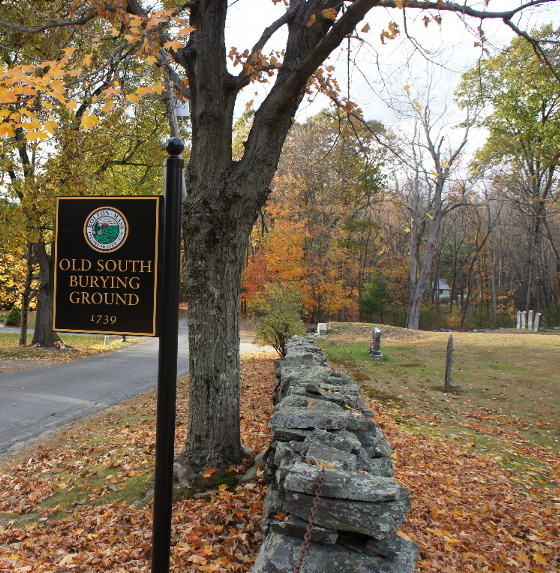
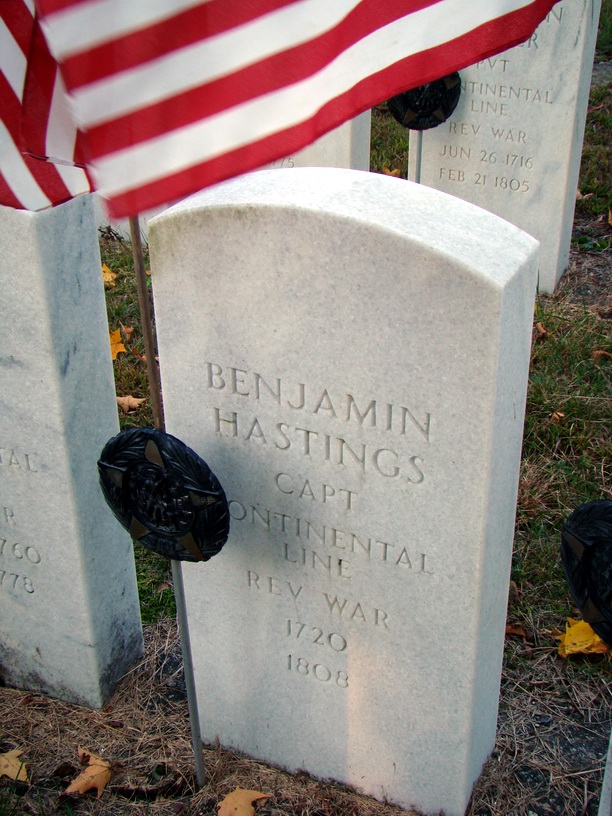
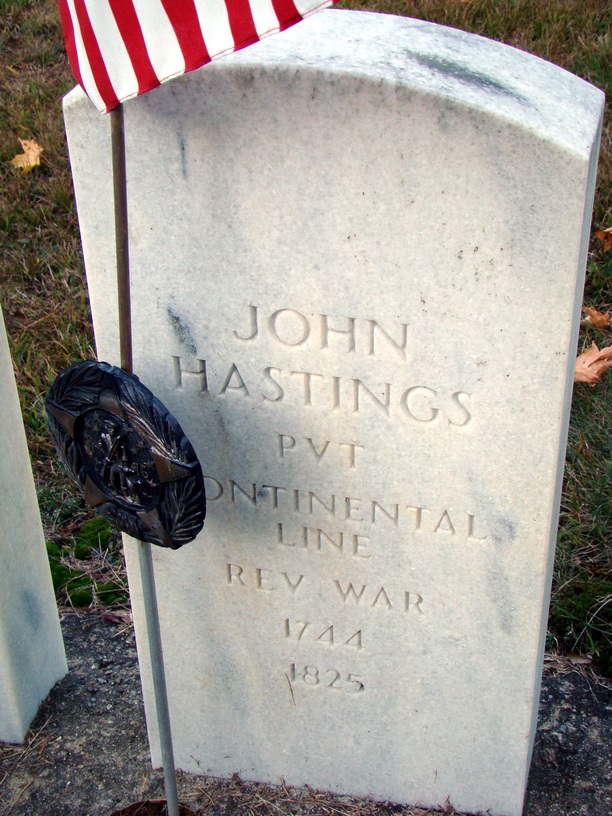
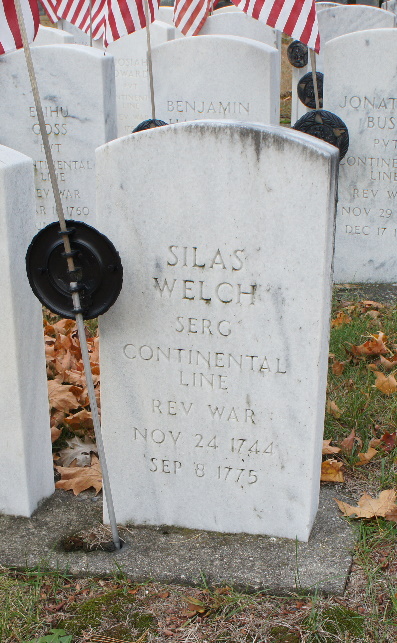
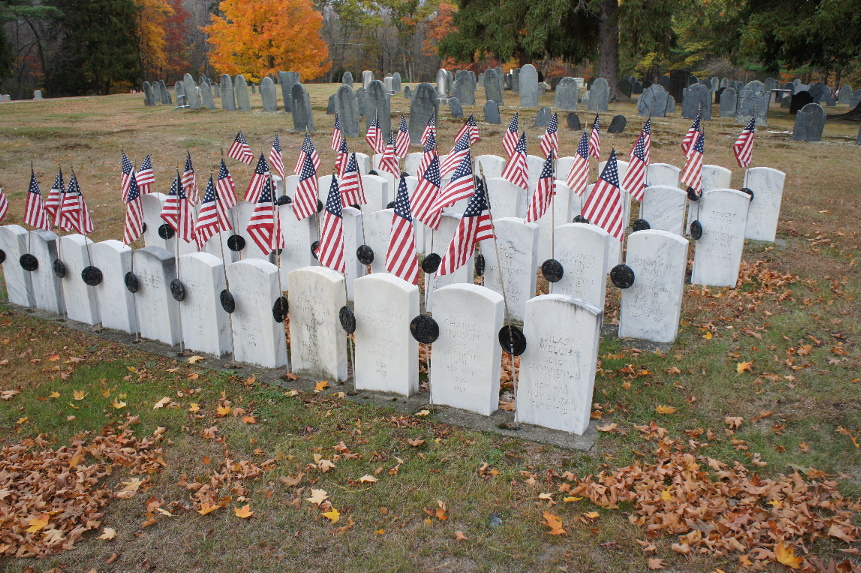
BENJAMIN | JOHN | SILAS
HASTINGS | HASTINGS | WELCH
CAPT | PVT | SERG
CONTINENTAL | CONTINENTAL | CONTINENTAL
LINE | LINE | LINE
REV WAR | REV WAR | REV WAR
1720 | 1744 | NOV 24 1744
1808 | 1825 | SEP 8 1775
The oldest child of SILAS and MARY was THOMAS WELCH, born 1768. When he was 18 he served a month in the military in an expedition against Shay's Rebellion in western Massachusetts. He then married LOVICE HASTINGS in 1791 and had seven children, all born in Bolton. They became members of the First Congregational Church in Bolton on Oct 11, 1801. LOVICE died in 1821, and the following year THOMAS married Mrs. Betsy (Powers) Carter, 23 years younger than him and with two children. They moved to Leominster, where their daughter was born in 1827. Census data show that THOMAS was a farmer and that he lived in BOLTON through 1820, and in Leominster from 1830 to 1850. In 1822 THOMAS and his son Silas sold part of their land to the town of Bolton for $100 to be used for the West Burying Ground. The son Silas and his sister Mary are buried in the cemetery. An 1831 map of Bolton shows THOMAS' house on what is now the corner of Green Rd. and Main St., with the cemetery near by. According to "The Biographical cyclopedia of representative men of Rhode Island", THOMAS "was a stern man of the old school, who trained his five sons with a rigorous hand. The services of his sons were required upon his lands until the age of twenty-one, or a suitable compensation was demanded. The three winter months were allowed them for study at a country school, the curriculum consisting of reading, writing, arithmetic." THOMAS died in Leominister in 1855 and is buried in the Evergreen cemetery.
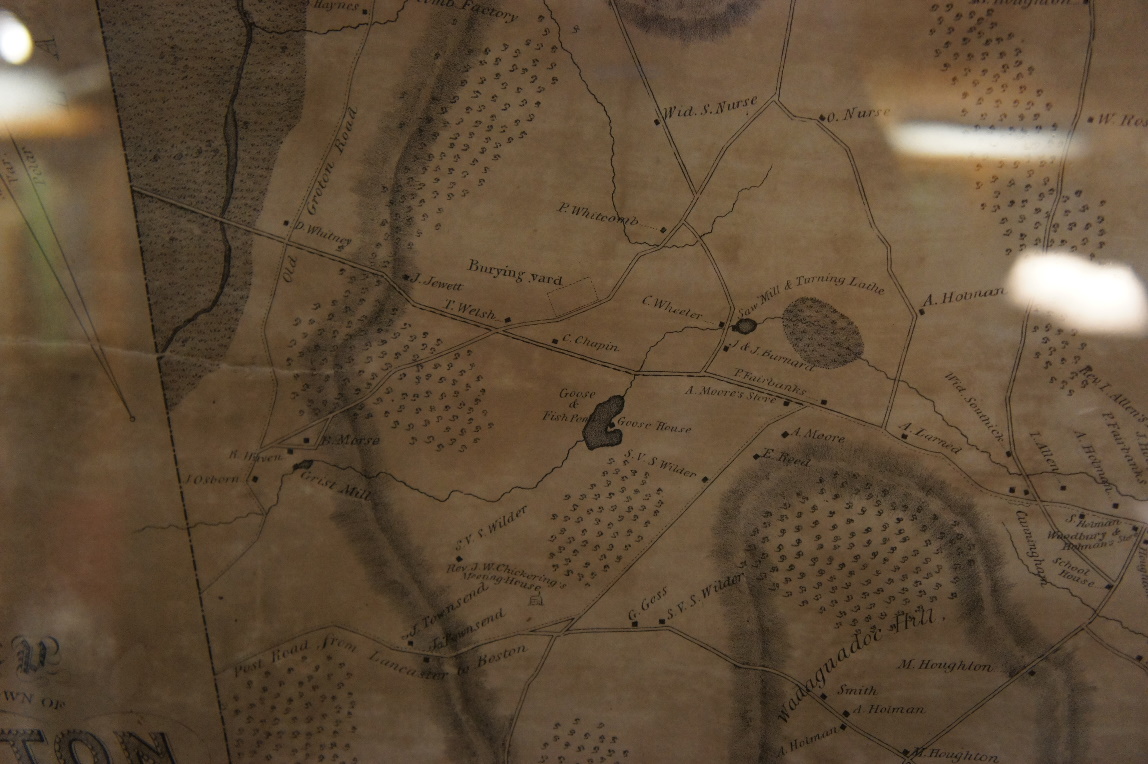
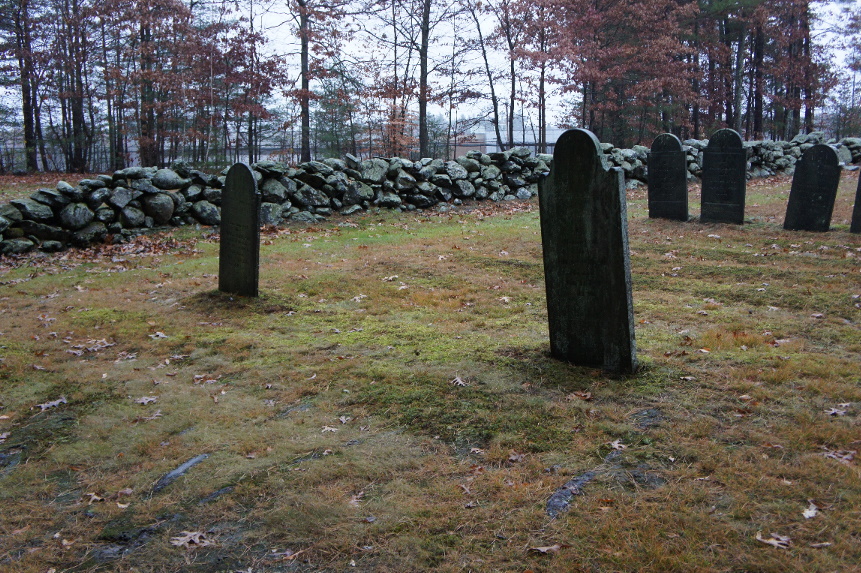
Left: 1831 map showing Thomas Welch's home and the West Burying Ground.
Right: Welch gravestones - left is Mary and right is Silas, both children of Thomas Welch;
beyond the stone wall and trees was Thomas' house and land, where now sits a modern high school.
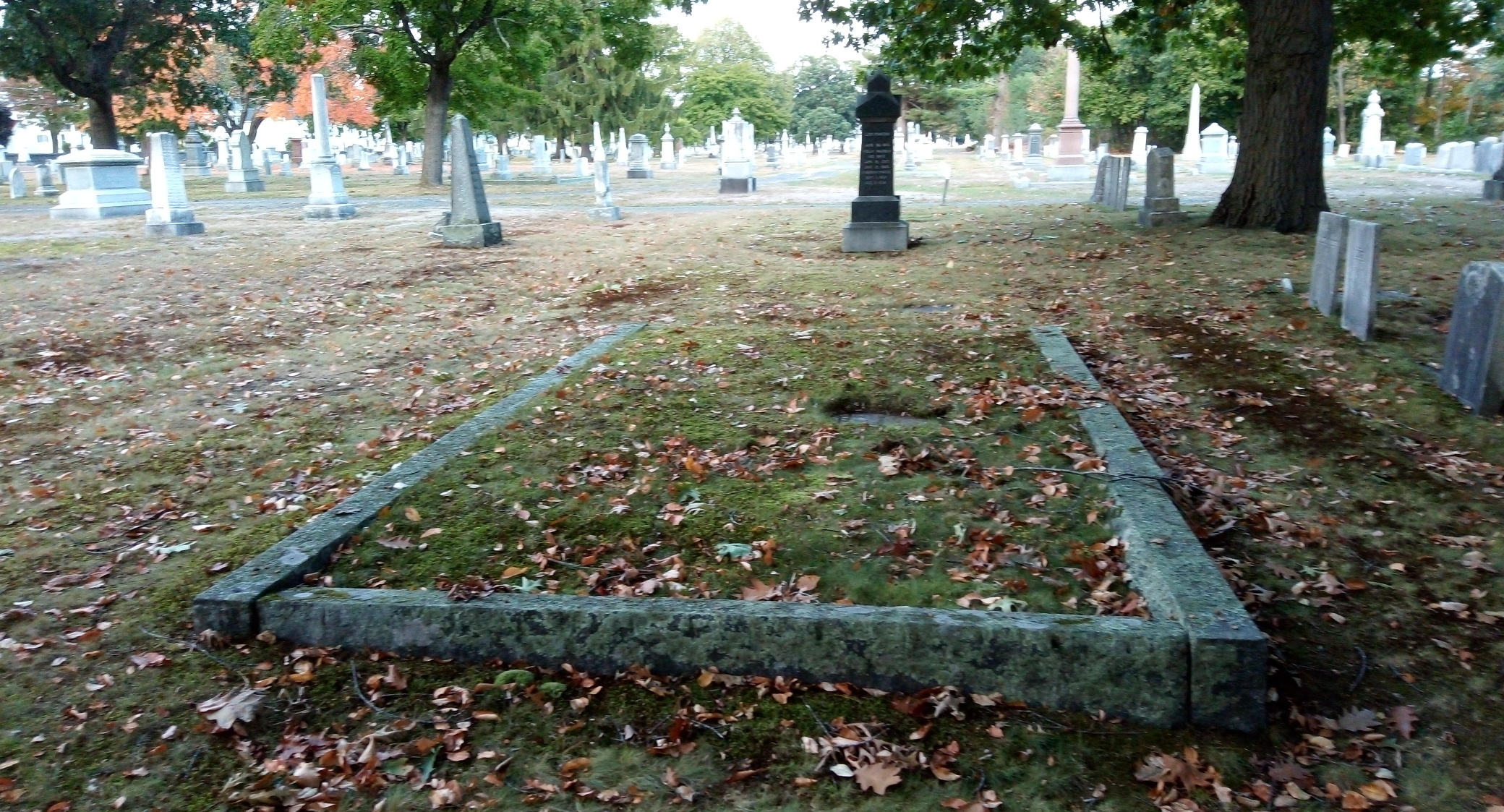
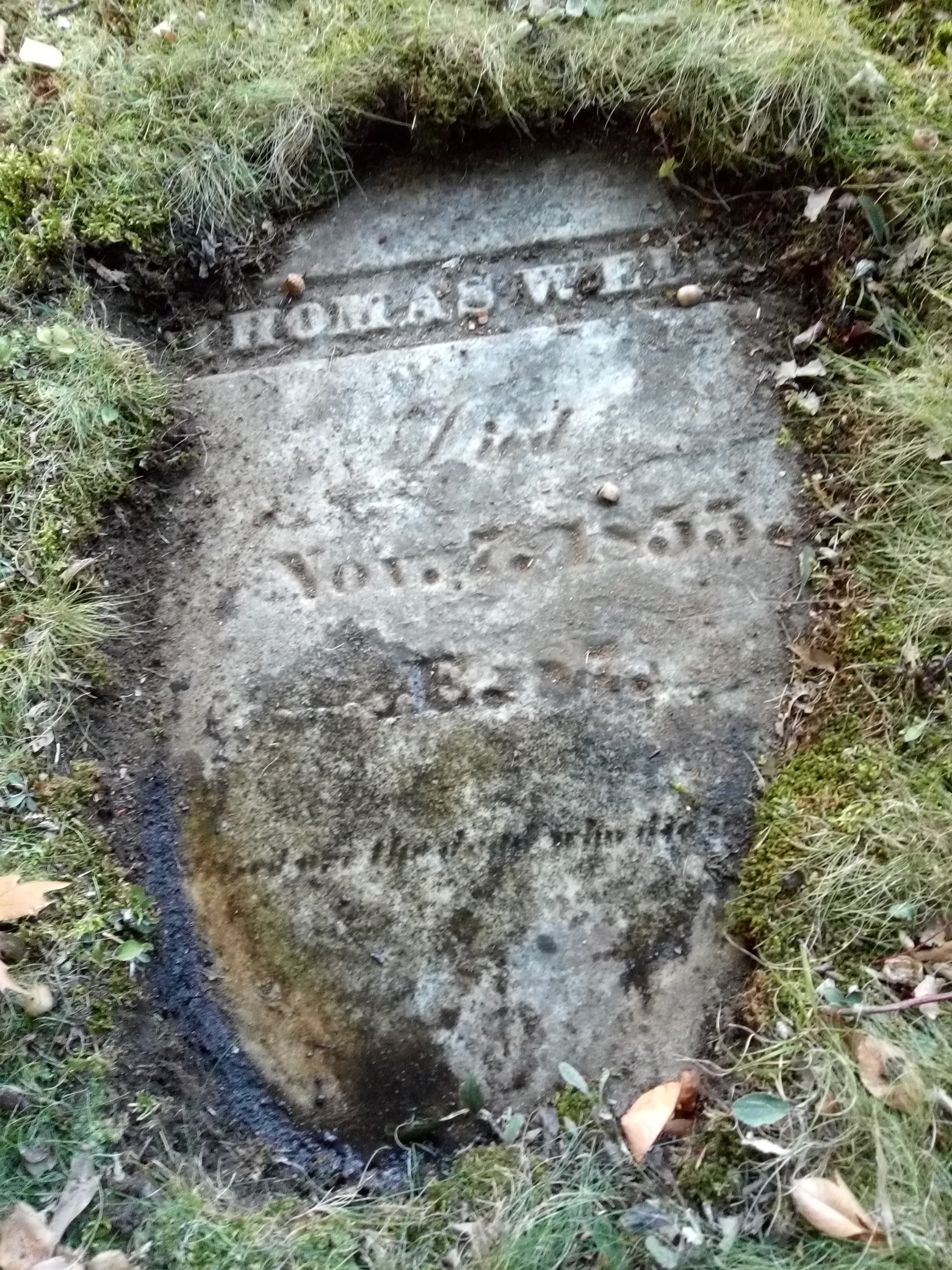
Left: photo looking northeast, with Thomas Welch's grave in the middle
of the small wall. There is room for another grave on either side of him.
Right: Thomas Welch gravestone
Thomas Welch Died Nov. 7, 1855. AE. 87 God xxx xxx xxxx who died
HORATIO NELSON WELCH was born in July, 1811 in Bolton, and moved with his father to Leominster while he was still a child. He was still living in Leominster in 1836 when he married ABIGAIL HEYWOOD of Lunenburg. The rest of his life is described in the Lunenburg Chapter.
Bibliography (all of these books can be downloaded and read from Google Books):
- "The early records of Lancaster, Massachusetts. 1643-1725" ed. Henry Stedman Nourse, 1884 [page 24 has signatures of John Prescott, Johath Prescott and others]
- "History of the town of Lancaster, Mass from the first settlement...", Abijah Perkins Marvin, 1879
- "History of the origin of the town of Clinton,Mass, 1653-1865", Andrew Elmer Ford, 1896
- "About Bolton", Esther K. Whitcomb, 1988
- "Stephen Gates of Hingham and Lancaster"
